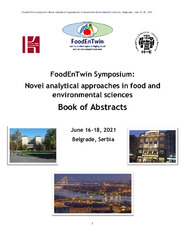Prikaz osnovnih podataka o dokumentu
Traut’s reagent application in fluorescent labeling of bovine serum albumin with phycocyanobilin
| dc.creator | Radomirović, Mirjana Ž. | |
| dc.creator | Gligorijević, Nikola | |
| dc.creator | Minić, Simeon | |
| dc.creator | Nikolić, Milan | |
| dc.creator | Stanić-Vučinić, Dragana | |
| dc.creator | Ćirković-Veličković, Tanja | |
| dc.date.accessioned | 2023-10-27T09:53:20Z | |
| dc.date.available | 2023-10-27T09:53:20Z | |
| dc.date.issued | 2021 | |
| dc.identifier.uri | http://cherry.chem.bg.ac.rs/handle/123456789/6032 | |
| dc.description.abstract | Phycobiliproteins (PBP) have been employed in numerous fluorescence-based techniques owing to highly fluorescent, covalently bound tetrapyrrole chromophores. So far, only entire PBPs have been utilized as fluorescent probes. A new method for covalent attachment of phycocyanin’s chromophore, phycocyanobilin (PCB), to potentially any protein, is proposed, relying on the ability of PCB to be attached to sulfhydryl groups of proteins. Traut’s reagent (TR, 2-iminothiolane) was exploited for introduction of sulfhydryl groups in the model protein, bovine serum albumin (BSA), by modifying its primary amines. Introduced sulfhydryl groups were then targeted for modification by PCB. All tested molar ratios of TR per mole of protein were successful in modification of BSA. Near-UV and far-UV circular dichroism spectroscopy revealed that a higher degree of modification by TR induces more profound alterations of BSA structure, leading at the same time to minor changes in BSA oligomerization and aggregation profile. PCB was covalently attached to introduced sulfhydryl groups at pH 9 at 20–fold ratio of TR. An increase in the molar ratio of TR per mole of BSA leads to amplification of fluorescent signal of PCB-modified BSA, most significantly observed starting from 50-fold and higher TR ratios. Using BSA as a model protein, a 50-fold molar excess of TR seems to be the optimal ratio for balancing between the effect on protein structure and the degree of labeling and thus fluorescent signal obtained. The proposed method could be used for labeling of virtually any protein, as means of either obtaining fluorescent probes for application in fluorescent techniques or functionalization of, for example, food proteins through covalent attachment of bioactive PCB. | sr |
| dc.language.iso | en | sr |
| dc.publisher | Belgrade : Faculty of Chemistry | sr |
| dc.relation | info:eu-repo/grantAgreement/MESTD/inst-2020/200168/RS// | sr |
| dc.relation | info:eu-repo/grantAgreement/EC/H2020/810752/EU// | sr |
| dc.relation | Serbian Academy of Sciences and Arts, grant number F-26 | sr |
| dc.rights | openAccess | sr |
| dc.rights.uri | https://creativecommons.org/licenses/by/4.0/ | |
| dc.source | FoodEnTwin Symposium “Novel analytical approaches in food and environmental sciences”, Belgrade, Serbia, 16th-18th June, 2021. In: Book of Abstracts | sr |
| dc.title | Traut’s reagent application in fluorescent labeling of bovine serum albumin with phycocyanobilin | sr |
| dc.type | conferenceObject | sr |
| dc.rights.license | BY | sr |
| dc.citation.spage | 37 | |
| dc.citation.epage | 37 | |
| dc.citation.rank | M34 | |
| dc.type.version | publishedVersion | sr |
| dc.identifier.fulltext | http://cherry.chem.bg.ac.rs/bitstream/id/33242/bitstream_33242.pdf | |
| dc.identifier.rcub | https://hdl.handle.net/21.15107/rcub_cherry_6032 |


